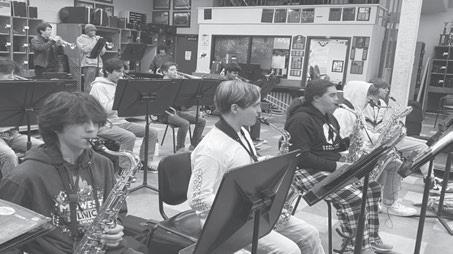






































































































WHS will implement a new bell schedule for the 2023–’24 school year, featuring new additions such as shorter passing periods, an earlier lunch break and a period 0 with possible hybrid options. is year, the current schedule did not earn 50% or more positive votes and thus did not get renewed.
“It didn’t get rati ed because there were a couple things we wanted to look at,” said Principal Jason Branham. “Number one, [we asked if] there was any way we could make lunch earlier. Number two, [we asked if] there was any way we can get out a bit earlier at the end of the day.”
e Uni ed Association of Conejo Teachers explored various scheduling options, including ve di erent bell schedules. ese alternatives consisted of traditional, block and modi ed block options.
“Every teacher gets to submit a ballot, and we do that over a week,” said Branham. “If the yeses are 70% or more, that bell schedule becomes adopted. 78% voted to approve [the new] bell schedule ... I’m optimistic for a couple reasons. It gives us an earlier lunch, [and] it also gives us an earlier [dismissal].”
Many students are satisfied with the outcome of next year’s bell schedule, especially since it shares similarities with the current schedule.
“I think it’s a good compromise, especially considering the feedback we heard in general from students and teachers,” said Ava Basile ‘23. “People wanted to get out a bit earlier, [and with] this bell schedule, we do get out a bit earlier.”

WHS sta is optimistic about the new
schedule, as the shorter passing periods will allow for an earlier dismissal time.
“[We wanted to] prioritize the [students that] wanted to get out earlier, [because] 3:28 p.m. is later than most of the schools in the area,” said Kim Michaud, Assistant Principal of Attendance and Student Welfare. “[We’re] trying to align [the schedules] more [for] people [who] have kids in multiple schools.” ough shorter passing periods and earlier dismissal times are notable changes, a de ning aspect of the 2023–’24 bell schedule is its period 0 beginning at 7:15 a.m. is is similar to the current period A option, but students only attend period 0 four days per week, and all students begin with period 1 on PLC days. With this new addition, WHS is exploring possible period 0 hybrid classes.
“[ e new bell schedule] gives us some exibility in our period 0 class,” said Branham. “We’re talking about period 0 classes [becoming] hybrid–type classes, so instead of coming in all four days, [students will] only come in two days a week, and the other days would be instruction through Canvas or asynchronous learning.”
Many students are excited by this prospective change, as they feel it broadens their options in schedule designs.
“If it allows us to o er a larger breadth of classes during that period, [then] I think it’s a great idea,” said Basile. “Since we are starting 10 minutes earlier next year due to the bell schedule changes, I think it’s nice for students to have the option to stay at home, and I can see it as a way for students to get a bit more sleep.”
However, some teachers are concerned that the continuation of a traditional schedule will not allot enough time for hands–on activities and projects.
Period 0 — 7:15–8:23
*No period 0 on Wednesdays
Period 1— 8:30–9:25
Period 2 — 9:32–10:27
Nutrition —10:27–10:33
Period 3 —10:40–11:35
Period 4 —11:42–12:38
Lunch — 12:38–1:13
Period 5—1:20–2:15
Period 6 —2:22–3:17
“ e shortcoming of the traditional schedule is that a lot of teachers have activities that are super involved, like labs for science, presentations or essays where [the] time [that is required] is slightly more than a class period,” said Scott Holloway, AP Physics C: Mechanics, AP Physics 2 and CP Physics teacher. “Having a block schedule will allow [teachers] to get deeper into content ... because when students leave the room, the content goes out of [their] heads, so keeping them there longer would [make for] a more powerful lesson.”
ough many educators feel that a block schedule would best bene t students, others believe that the option would need to be further researched in order to properly thrive.
“If we’re still at a place where we want to consider a block in the future, we need to visit some schools that are doing it even outside of our district,” said Branham. “We need to really look
at it, because teaching on a block is completely di erent from traditional [schedules], and learning on a block is completely di erent from learning on a traditional [schedule]. One of the concerns is that block [periods] are a long amount of time, and if we don’t adjust how we teach and we learn, then it’s not going to be good for kids.”
e implementation of a new schedule requires administration and sta to come together for the bene t of WHS, and many attribute the new changes to be a result of e ective communication and participation.
“I give a ton of credit to our teachers and sta ,” said Branham. “ ey’re all professionals, and we can all say, ‘I think this will work or that will work,’ but at the end of the day, we have to come together as one and [ask], ‘What is the best thing for our school as a whole?’ is bell schedule re ects that.”
e WHS Academic Decathlon team competed at the state–level competition in Sacramento March 24–26 and won ve individual awards.

A er winning multiple awards at the Ventura County level, including placing rst as a team overall, the WHS AcaDeca team went to state, competed against other high schools in California and took home multiple individual awards. John Connell ‘23 and Amelia Daisa ‘23 won gold in interview, Siddarth Bommareddy ‘24 won bronze in math, Arjun Malaviya ‘24 won silver in math, Donovin Atkinson ‘24 won bronze in speech and Alex Chi ‘23 surpassed a score of 7,000, thus achieving the highest team score.
“I’d say that the state competition is de nitely a lot more competitive than [the] county’s,” said Chi prior to the event. “But, we’ve been studying hard and preparing, so I hope that we’ll be able to replicate what we did at county at the state competition.”
Leading up to the competition, nine participants were chosen for the team, including Atkinson, Ryan Badakhsh ‘24, Bommareddy, Chi, Connell, Ren Daniel ‘24, Daisa, Ava Klein ‘24 and Malaviya. ey studied and practiced their material in all ten categories: art, economics, essay, interview, language and literature, mathematics, music, science, social science and speech.
there is a milestone for getting 7,000, and I was two–four points away,” said Bommareddy. “Other than that, I think I did really well because I got a medal in math, and I’m pretty happy with that.”
Having teamwork is also an essential part of the Academic Decathlon team’s success; each person is essential in helping the team score well.
“I think I bring a lot of positivity and energy to the team,” said Malaviya. “Everyone on the team plays an important role. Coming in every day with a positive attitude, [being] ready to help the team and doing your best is just as important of a role because if you have even one bad apple in the bunch, it will a ect our chances. It’s important for everyone to play their part.”
A er its state competition, the team is looking forward to preparing for next year’s new material to perform even better than this year.
“[
e state competition has] three divisions that they compete in, and California has the best Academic Decathlon teams in the world,” said Connell. “Every year, [schools such as] Oxnard High School [and] Beverly Hills High School win nationally, so our chances of winning the competition are [slim].”
is competition marks the end of the AcaDeca seniors’ time in the program, which leads to some sentimental moments and feelings as it comes to a close.
“It was a fun experience,” said Connell. “It being my senior year, I wanted to go out with a bang, and Academic Decathlon has been something I really care about the last few years, so being able to get third in the county and move on to the state division was kind of an achievement for me as an individual.”
e competition also served as a checkpoint for AcaDeca members’ personal growth.
“I think I did a little better than [at] county, but [I was] still a little disappointed because
“Next year’s [theme] is going to be computer science,” said Daniel. “It’s technology and innovation. at means our literature books will be science ction and our music is going to be from sci– movies and [other forms of media]. Our history will be [the] history of computers, so it’s de nitely going to be interesting.”
Although there were highs and lows during the competition, the team re ected positively on the experience as a whole.
“Our team did a great job,” said Malaviya. “For the amount of work we put in, we got a proportional result. I think it was what we expected.”











































































































American capitalism is based on the idea that anyone can rise to the top if they put in the time and e ort; however, society is deeply rooted in keeping the wealthy at the top and poorer people at the bottom. One of the best demonstrations of this is college and its application process, in which wealthy individuals hold an extreme advantage.
Firstly, wealthier students have a leg–up in building impressive academic records throughout high school, even if they don’t attend expensive private schools. ey are more likely to be able to a ord tutoring, o en have more time for studying or extracurriculars as opposed to working to help support their families and live in communities like Westlake Village which o er opportunities to attend higher–level schools such as WHS.
However, the advantages that wealthier students have are most seen in the college application process.
Wealthier families can o en invest in college counselors, which cost $4,000–$6,000 on average, according to ivycoach.com. College counselors guide students through the college admissions process, helping them select schools, answer application questions and write essays, giving such students a signi cant advantage over students who are unable to a ord a counselor. Many less–wealthy students may also be the rst in their family to attend college, making them unable to even ask their parents for help or advice.
to submit SAT and ACT scores, and many top schools still require them.
Even if a less–wealthy student manages to break through the obstacles they face and get accepted into top universities, the ability to attend said schools is another issue. For students with severely low incomes, nancial aid can o en cover enough to make attendance possible; however, many students who fall in the middle won’t receive enough aid to make attending costly schools feasible. While student loans are an option, many people are hesitant to take out loans knowing they’ll carry the debt for 10–30 years, according to bankrate.com

e college admissions process fuels the issue across the United States where people born into wealth easily hold their place high on the social pyramid, possibly ascending even further with higher–education, while those born into poverty face a myriad of obstacles when pursuing a college education and thus are more likely to go down a di erent and likely less pro table route.
“Society is deeply rooted in keeping the wealthy at the top.”
While not attending college does not mean an unsuccessful life, Bachelor’s degree holders are half as likely to be unemployed as their peers who only have a high school degree and make $1.2 million in additional earnings on average over their lifetimes, according to aplu.org
Two more months. Two more months and the life I have always known will completely change forever. With college right around the corner, many seniors, including myself, are struggling to stay present in the current moment as opposed to dreaming about how di erent life will look in only a few months.
is little, pestering feeling constantly nags the back of my head — all day and every day — senioritis. e thought of studying and completing assignments to the fullest of my extent seems to lack importance compared to what really lls my mind — graduation, college decisions, the search for a roommate, my future dorm decor and my last few months at home with friends and family.
In addition to my seemingly enormous course load, which only consists of reading a few chapters of our AP Literature novel each week and nishing a few math problems, attempting to nish one task in particular takes up the vast majority of my time and energy — deciding where I want to go to college.
A er being rejected from my dream school, I thought that my whole entire world was crumbling down. I questioned everything I did during my high school career and became angry with myself for not starting a charity for chimpanzees in the Congo or for not nding a cure to cancer — all the necessities to get into a top school nowadays.
On the far less dramatic side, in reality this rejection was the start of a whole new realm of possibilities for me. Before, I hadn’t even taken the time to consider other options. My mind was set on one thing only, which was going to my dream school.
However, now that I have explored di erent colleges in di erent cities with di erent programs, majors, professors and even di erent values, I have an even bigger issue at hand: which one do I choose?
On a similar note, if a student’s parent or other family member did attend college, the student will have a much greater chance of being accepted into their relative’s alma mater. According to forbes.com, 80% of the 64 four–year colleges and universities that admit less than 25% of applicants report giving an advantage to children of alumni.
Additionally, wealthier students are more likely to have the option of SAT prep classes or tutors. Although the SAT and ACT are no longer considered by many schools, such as the University of California and California State University systems, many Common App schools still have the option
e many advantages that wealthier students have throughout high school and the college application process inarguably create an uneven playing eld when it comes to being accepted into and attending certain colleges. Despite the fact that college admissions o cers do not directly consider income when deciding whether or not to admit a student, they do, in a sense, discriminate based on income as they consider academic achievement, involvement in school, standardized test scores and personal essays or statements, all of which are impacted by a student’s income and their ability to a ord certain resources.
Attending a high–level college is, of course, not the only way to become successful and nancially stable. However, college opens up many doors and o en provides the greatest chance for a successful career. e capitalistic idea that “working harder” guarantees one a high–level education and a successful career is simply untrue, as it’s always been much easier to get to the top when starting from up high.
Last year, my biggest decision was trying to pick which avor of ice cream I wanted most — strawberry, oreo, mint chip; the options were endless. Picking a college kind of feels like that, only this decision will a ect the next four years of my life and probably even the rest of my future. at’s not scary at all. Right?
Wrong. I am constantly terri ed that I will make the wrong decision. However, I know that this is an extremely normal fear and one that almost everyone has to endure. I have decided not to let the daunting unknowns of my future consume my mind at all times anymore.
While this whole college admissions process has been overwhelming, it has also been extremely rewarding and exciting. Staying present for the last few months of high school and remembering that future change is a natural part of life has become most important to me.
While the unknown can be scary, it also brings new opportunities and experiences. Embrace the changes that lie ahead and summon the strength and resilience to navigate them.







e WHS boys lacrosse team has earned a 7–1 record overall and is ranked No. 6 in California and No. 21 in the nation through hard work and perseverance.
Boys Lacrosse Coach Pete Swander has led the WHS boys lacrosse team to many CIF playo games throughout the years with his hands–o coaching style that allows his players to play hard and fast.
“It’s how I learned to play,” said Swander. “It is a lot of fun to play [hard and fast], and then you nd sources of energy in your teammates.”
An integral part of a successful team and season is having a positive and encouraging coach who pushes athletes to nd and overcome their limits.
“With our coach honing in on those little details and making us focused, we’re able to beat [other] teams,” said lacrosse player Jack Follette ‘24. “Even if they’re the same skill–wise, ... it comes down to those little details.”
Another important quality of a coach is having the ability to create an environment where players feel comfortable while motivating them.
“[Our] coaches know when it’s time to be disciplined but also know when to have fun and to just let us play,” said boys lacrosse captain Aiden Whitehouse ‘23.
rough this healthy coach–player relationship, players can connect with each other and build trust as a team, which they value on game days.
relationships with each other are vital for a team’s success in the long run.
put pressure on the guys who are expected to produce and do well.”
(as of March 27)
ou can tell there’s a bond there. We’re not teammates; we’re brothers.”
“The way [Swander] coaches is very hands–off,” said boys lacrosse captain Crew Morrow ‘23. “He lets us decide what we want to do, and I think that works in regards to more of a team aspect.”



Even though coach and player relationships are important for team trust and athletic progress in both practices and games, players’
“Y“[The seniors are] older [and] they have way more experience, so they [are] able to teach me and kind of coach me in ways that my coach couldn’t,” said Follette. “It wasn’t just technical things; it was the way to act and just the little things to help [me] compete with those bigger guys.”
e pressure that comes with teams excelling in their leagues is o en overlooked; however, it a ects players in a much more profound way than many people may believe.
“ e pressure is there to perform, especially when our coach knows the capability of our playing style,” said Morrow. “It does
At the end of the day, what keeps the team together on the eld is the bond the players share with one another. e positive environment fostered throughout the season helps them work together as a team.
“You can tell there’s a bond there,” said Morrow. “We’re not teammates; we’re brothers.” You want to play for each other. If [a player isn’t] playing for themselves, [then] they’re playing for the guy next to them.”
When the coaches let the players and captains play and lead how they choose, it fosters a strong relationship between members of the team.
“It’s a player’s game,” said Swander. “They have to make decisions on the field ... We try to teach them how to make good decisions in practice and let them do what they see in games.”
“ e coaches, the people and the team really made me feel at home. e level of play ts me and my goals to be playing at that kind of program.”
“ e team is pretty tight knit, and [everyone] does a lot of things together. Santa Barbara is a really beautiful place, and it’s right on the water. You can’t beat it.”
“I loved the coach and the girls. e environment of the school is exactly what I wanted, so I’m really excited to start playing there.”
Compiled by Junior Rendon
Record: 9W–3L
Next game: March 30 vs. Agoura @ WHS
Record: 14W–3L
Next game: March 30 vs. Oaks Christian @ WHS
boys
Record: N/A
Next game: March 30 @ River Ridge Gold Course
boys
Record: 8W–1L
girls stunt
Next match: March 30 vs. Calabasas @ WHS
Record: 3W–1L
Next meet: March 29 vs. Thousand Oaks @ WHS
Record: 8W–5L
Next game: March 31 vs. Thousand Oaks @ WHS
L S
Record: 8W–1L (boys) 6W–3L (girls)
Next game: March 29 vs. Agoura @ WHS
Record: 3W–0L (boys) 1W–2L (girls)
Next meet: March 31 vs. Newbury Park @ NPHS
Record: N/A
Next meet: March 30 vs. Agoura @ AHS
boys girls
Record: 5W–5L
Next game: March 30 vs. Calabasas @ Westlake YMCA
Compiled by Kalia Bell
–Crew MorrowLex Sahagian ‘23










